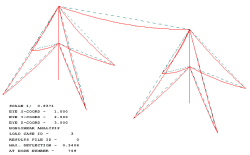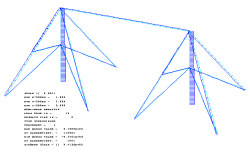Case Study
Cable Stayed Mast Structures
LUSAS Civil & Structural analysis software can be used to
analyse a wide variety of cable stayed structures such as masts, towers, and cable stayed
roofs. LUSAS has advanced cable elements that can be prestressed, carry no bending load,
and exhibit catenary properties to allow accurate analysis of both self-weight and wind
loading effects on these types of structures. In addition, critical member buckling loads
can also be obtained
 The modelling of cable stayed masts is ideally suited to using the LUSAS
parametric language. This scripting language allows engineers to automate the modelling
and loading of masts having a similar overall structural layout or arrangement. After an
initial mast model is created, graphical menus and forms can be defined allowing engineers
to enter data for similar masts with a minimum of effort. Dimensional data such as mast
height, height of ties, radius of cable anchor points and cable diameters together with
loading details such as pre-tension in the cables, wind speed, drag coefficient, and angle
of incidence can all be entered on user defined forms. The modelling of cable stayed masts is ideally suited to using the LUSAS
parametric language. This scripting language allows engineers to automate the modelling
and loading of masts having a similar overall structural layout or arrangement. After an
initial mast model is created, graphical menus and forms can be defined allowing engineers
to enter data for similar masts with a minimum of effort. Dimensional data such as mast
height, height of ties, radius of cable anchor points and cable diameters together with
loading details such as pre-tension in the cables, wind speed, drag coefficient, and angle
of incidence can all be entered on user defined forms.
Whilst masts are relatively simple structures, nonlinear
analysis is required in order to model the geometric nonlinearities (P-delta effects) in
the cables. Nonlinear analysis with LUSAS provides automatic load incrementation,
automatic step reduction upon convergence failure and flexible restart facilities - all
designed to enable newcomers to nonlinear analysis to produce results as easily as
possible.
 A comprehensive set of results can be obtained. Printed text
output, graphs, annotated screen plots or full animation sequences can be produced to
show: A comprehensive set of results can be obtained. Printed text
output, graphs, annotated screen plots or full animation sequences can be produced to
show:
- Displacements in tower and cables
- Bending moments in tower frames
- Shear forces at tower base
- Tension forces in cable
- Buckling of the tower frame
LUSAS Civil & Structural
analysis allows quicker what-if? assessments to be performed to evaluate the structural
response of mast structures for different cable tensions, diameters and arrangements. The
parametric scripting language is particularly useful for enabling occasional users of the
software to complete relatively advanced analyses.
|